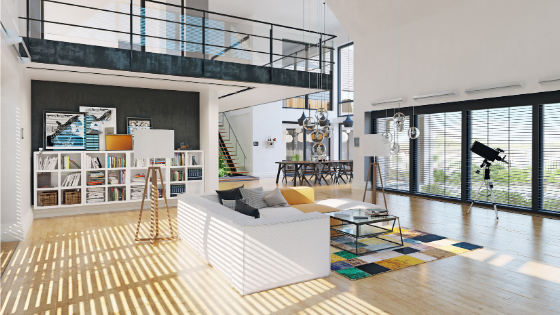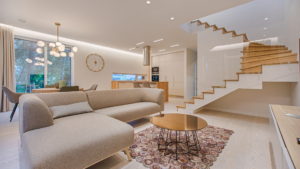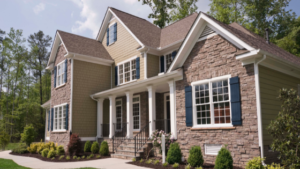Residential homes with open concept floor plans have been sought after by homebuyers since the late 1990s. This is likely because open floor plans typically optimize available space, create a welcoming and spacious feel, and are aesthetically pleasing. However, there are a few quirks about open living spaces not everyone loves.
For example, one quirk we often hear from our residential painting clients is, “Can we create an accent wall in our open concept living space?” We love this question, and before we answer it, let’s take a quick look at why homeowners should consider an accent, or feature wall, in their design plan.
Accent Wall Benefits
What is an accent wall?
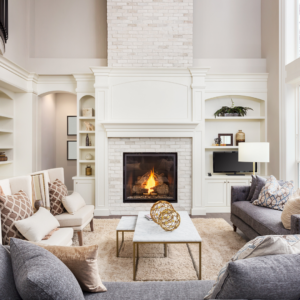
Accent walls are interior walls that are designed differently from other walls in the room. This is often achieved using wall paint that differs in colour from other walls, adding a different texture using wallpaper or other creative features.
Why create an accent wall?
Accent walls can accentuate a desirable focal point in a room, change the feel or atmosphere of a space, or make a room seem larger or smaller than it actually is.
For example, a homeowner has a living room with a beautiful, white porcelain fireplace they want to use as the room’s focal point. An easy way to do so is to use a distinct wall colour that is different from other walls in the room, around the fireplace. This becomes an accent wall that will inevitably draw people’s eyes towards the luxurious design element.
Say Yes to Accent Walls and Open Concept Spaces
As we explained above, homeowners have excellent reasons to create an accent wall as part of their home interior design plan. And yes, this information applies to open concept floor plans as well.
But, before you start, be sure to research and plan the project with care and consideration. Read our following tips and then reach out to our expert painters to have any lingering questions answered. We’ve been painting homes in Victoria, BC, for over 30 years. We can help you determine the best way to create a stunning accent wall to make your home’s open living space flourish.
Define the Accent Wall Boundary Using Architecture
In open living floor plans, it’s not uncommon for a single wall to extend the length of multiple living spaces without a defined border. This can be awkward when determining a good spot for an accent wall. In this situation, it’s best to let architectural features beyond the traditional corner or doorway choose your accent wall’s boundaries.
When determining where one room ends and another begins in an open concept floor plan, use the following guidelines:
- Kitchen architecture. Kitchen islands or cabinetry can easily define an accent wall’s boundary.
- Windows
- Flooring transitions
- Fireplace
Lacking an Architectural Boundary? Create One!
If your open space floor plan lacks an easy-to-define boundary, don’t worry, you can still plan that accent wall you’ve been dreaming about. All you have to do is create its border yourself!
To break up a large room’s vastness, such as in a great room or multi-purpose living area and that also appears seamless, consider the following ideas:
Built-In Bookshelves or Entertainment Cabinetry
Bookshelves, entertainment units, or custom cabinetry signal to the eye that the purpose of the space is changing. Flanking either side of a desired focal point and accent wall area with an item that also determines a boundary will help direct eyes to your preferred focal point.
Curtains or Drapery
Drapes can be used for more than privacy and light control. For example, they can be used to create zones in an open concept living space. And, when designing a feature wall in a large room, curtains can be used to hide transitioning paint lines.
Choose Complementary Colours
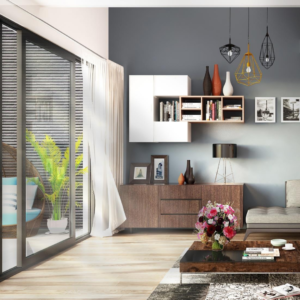
An accent wall is intended to stand out more strategically than other wall surfaces. However, it’s important to prevent it from overpowering the room. Ideally, an accent wall should be a slightly bolder representation of the room’s overall aesthetic design.
Accent walls should complement the room and not be overly contrasting. For example, if the primary wall colour of an entryway is white, an option for the accent wall could be the same tint of white, just two shades darker. Or, use the same colour of wall paint but use one with a different sheen property for an attractive option.
Expert Accent Wall and Paint Design Tips from Moloney Painting
The walls of every home work hard for its occupants. Walls provide security, privacy and offer the chance to express personal style and individuality. Be sure to show your walls the love and care they deserve! When you’re ready to update or refresh the walls of your home, be sure to hire the painting pros you and your walls can rely on to do the job right.

